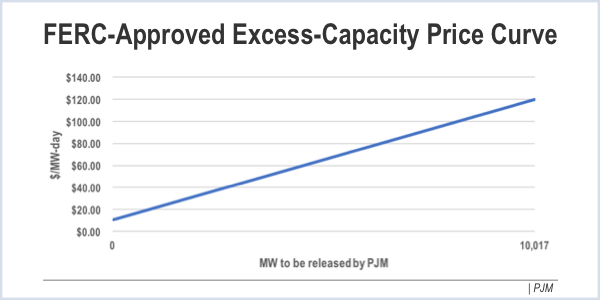By Rory D. Sweeney
FERC has approved PJM’s proposal for selling back excess capacity in this February’s third Incremental Auction for the 2017/18 delivery year.
The commission, however, agreed with objectors on several points, prompting it to require key revisions to the plan (ER17-335).
“While we acknowledge deficiencies in PJM’s filing … we also agree with PJM that it is just and reasonable for PJM to alter the shape of its sell-back offer curve to a straight line, eliminating the potential that the relevant Incremental Auction could clear at or near $0/MW-day,” the commission said.
The proposal dealt with PJM’s transition to the Capacity Performance market construct, which was approved in 2015 and gradually implemented over the 2016/17 and 2017/18 delivery years. The RTO had already obtained capacity for those years under previous rules, so the approval also established two transition auctions to procure any additional capacity needed.
The transition auction for the 2017/18 delivery year saw the RTO procure 10,017 MW of previously uncommitted capacity. PJM holds three IAs following the initial Base Residual Auction for a specific delivery year, during which committed capacity resources can buy back their supply obligations and PJM can acquire or release capacity in response to updated load forecasts. The IAs for the transition years also covered the results of the transition auctions.
The methodology PJM used for releasing excess capacity from the 2016/17 delivery year resulted in 4,818 MW sold at an average price of $4.79/MW-day, and PJM warned that using the same process to release any of the 10,017 MW for 2017/18 would potentially result in an offer of $0/MW-day — with no money flowing back to load.
To better reflect the capacity’s value, the grid operator proposed an alternative approach that would identify any necessary changes to the amount of capacity the RTO had already procured and create a price curve for selling any excess.
PJM additionally proposed that any excess that doesn’t sell at the auction would not be eligible to become excess-commitment credits. PJM creates the credits from excess capacity that doesn’t clear IAs and allocates them to load-serving entities, who can trade them or use them to replace existing capacity requirements. (See “Proposal Chosen for Capacity Release,” PJM Markets and Reliability and Members Committees Briefs.)
FERC approved PJM’s plan but ordered several changes in recognition of objections made by American Municipal Power. The commission directed PJM to revise the price curve so that it begins at the lowest price point on the current sell-back offer curve and ends at the BRA clearing price for that delivery year. It also ordered allocating uncleared excess capacity as excess-commitment credits and consolidating separate capacity sellbacks into the single auction.
“Performing two auctions in this manner will result in creating two prices for the same product in the same auction, without any justification for the different price,” the commission said.
FERC clarified that the approved changes to the sell-back procedure only apply to the third IA in February.
PJM Independent Market Monitor Joe Bowring was surprised the commission put so much effort into what he felt was a minor detail, but he was still disappointed that his office hadn’t intervened in the docket. During discussions to secure stakeholder endorsement of PJM’s proposal, the Monitor repeatedly objected to the plan.




